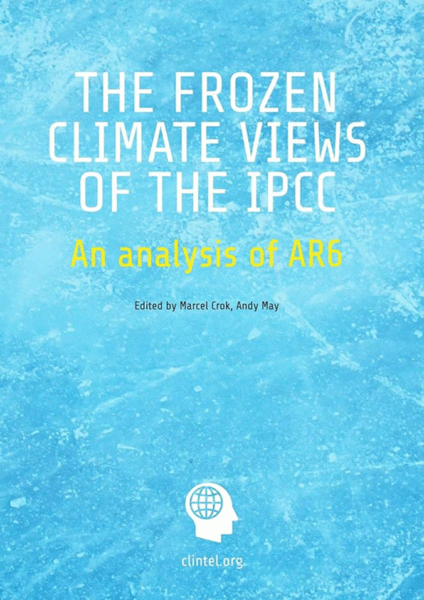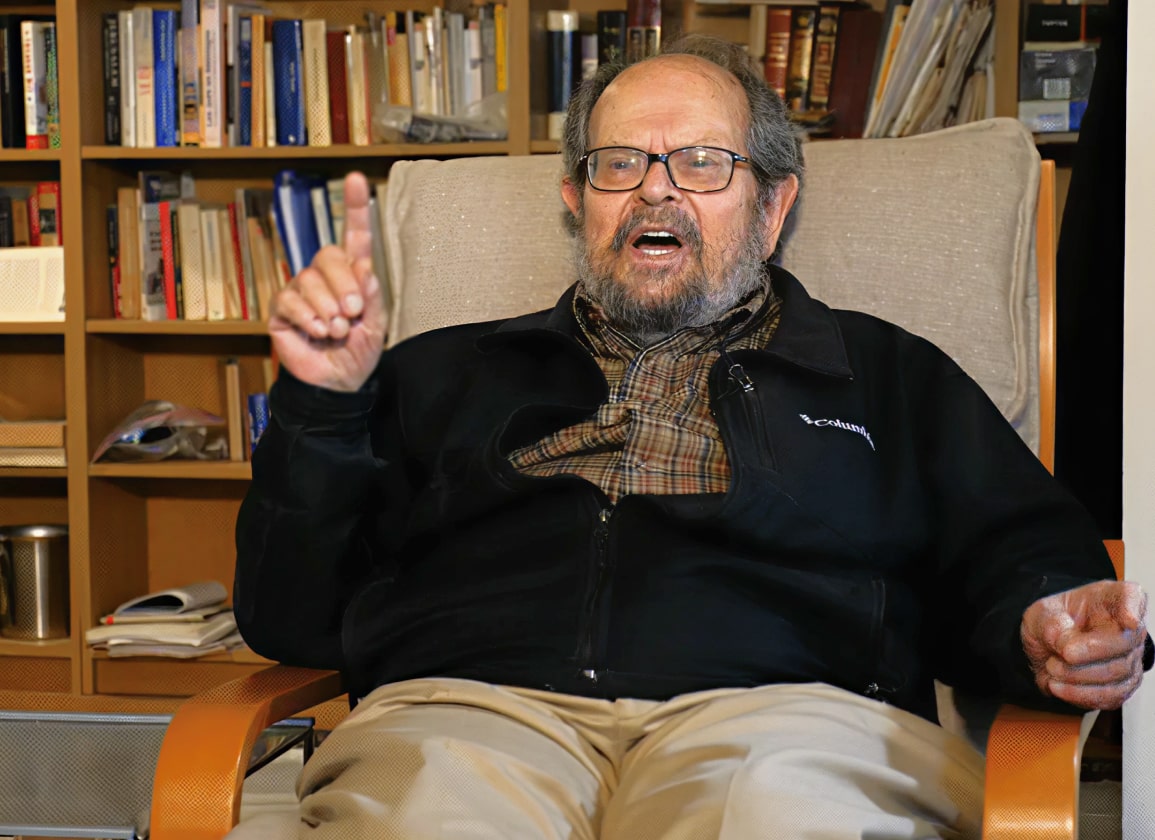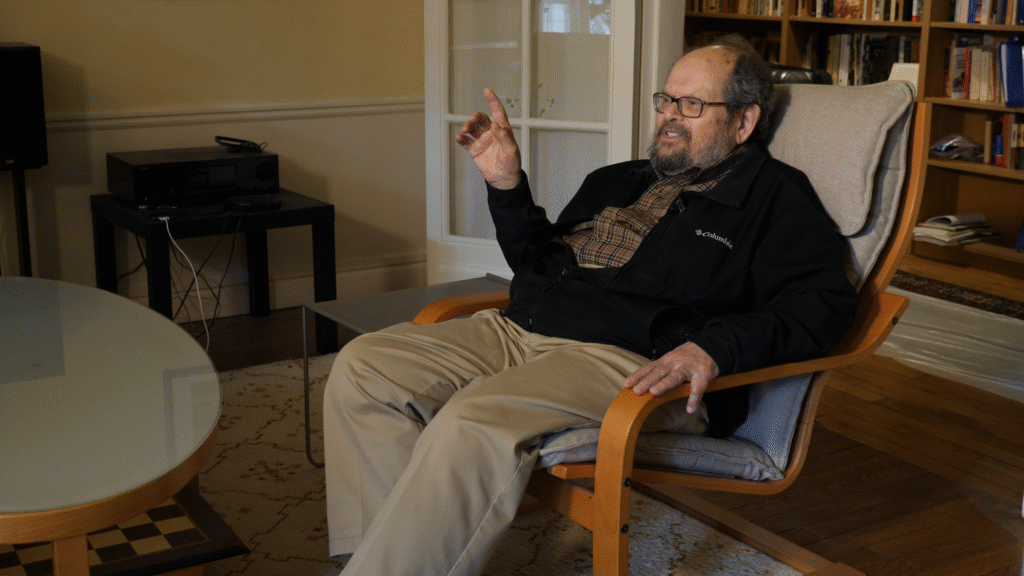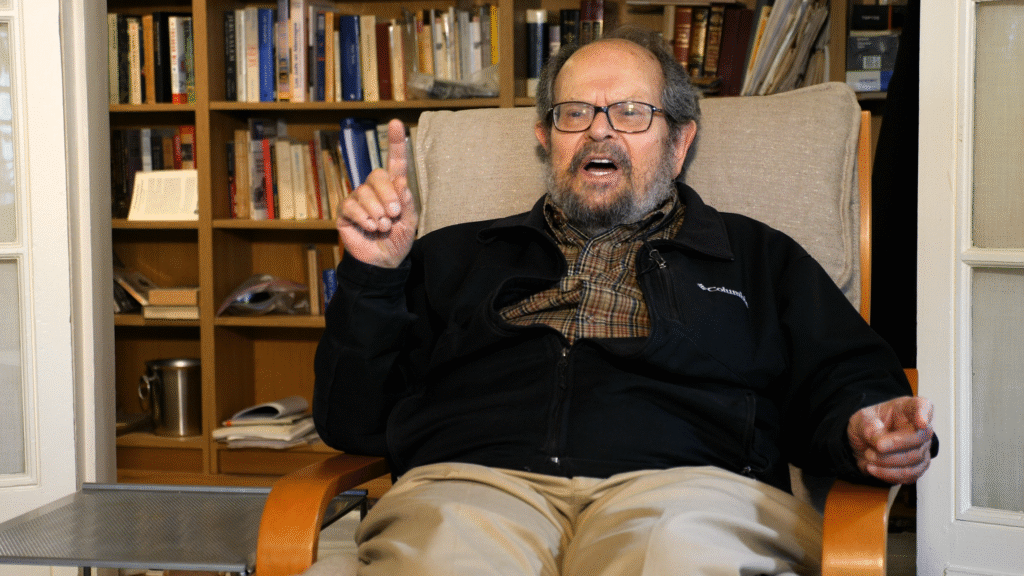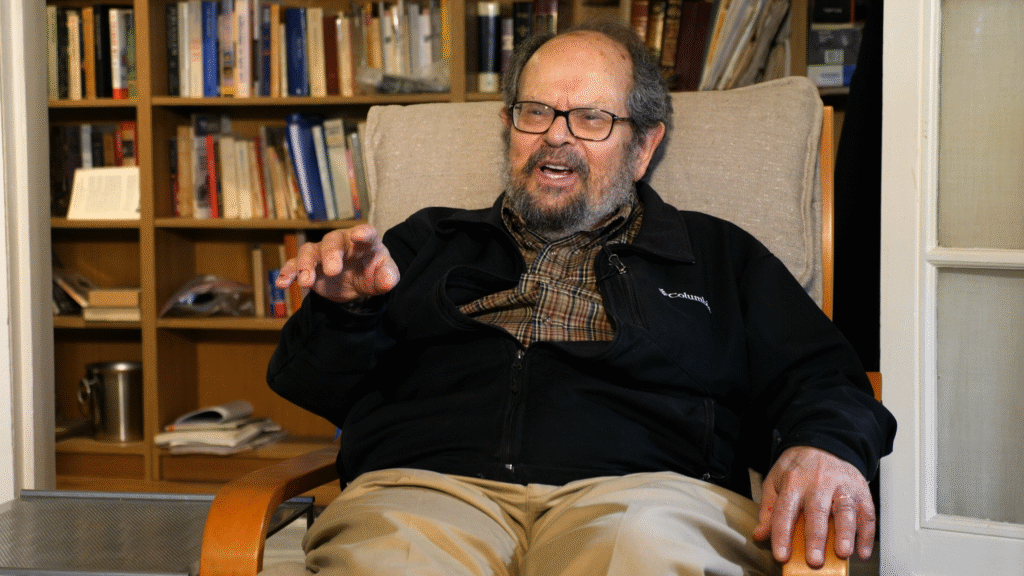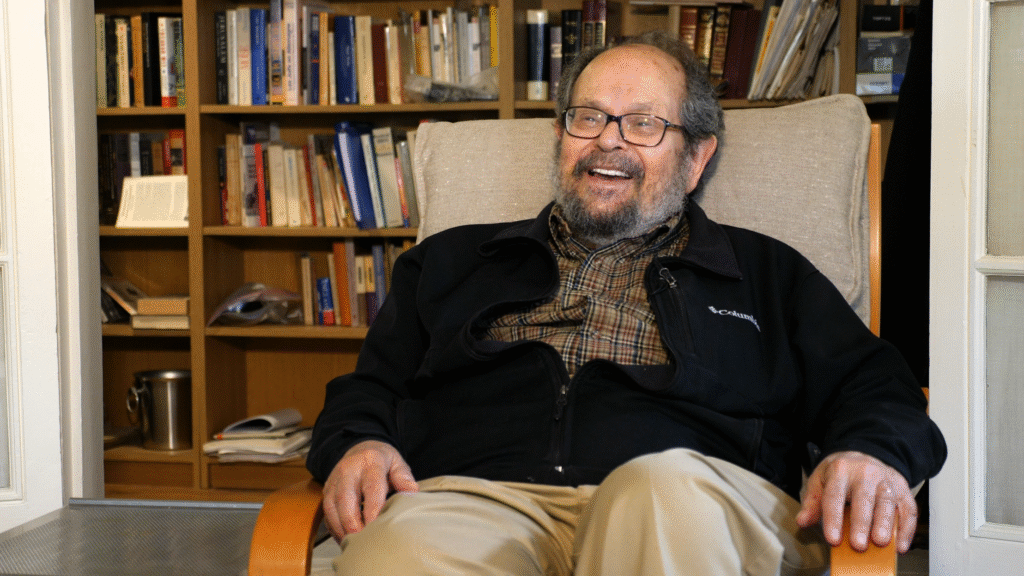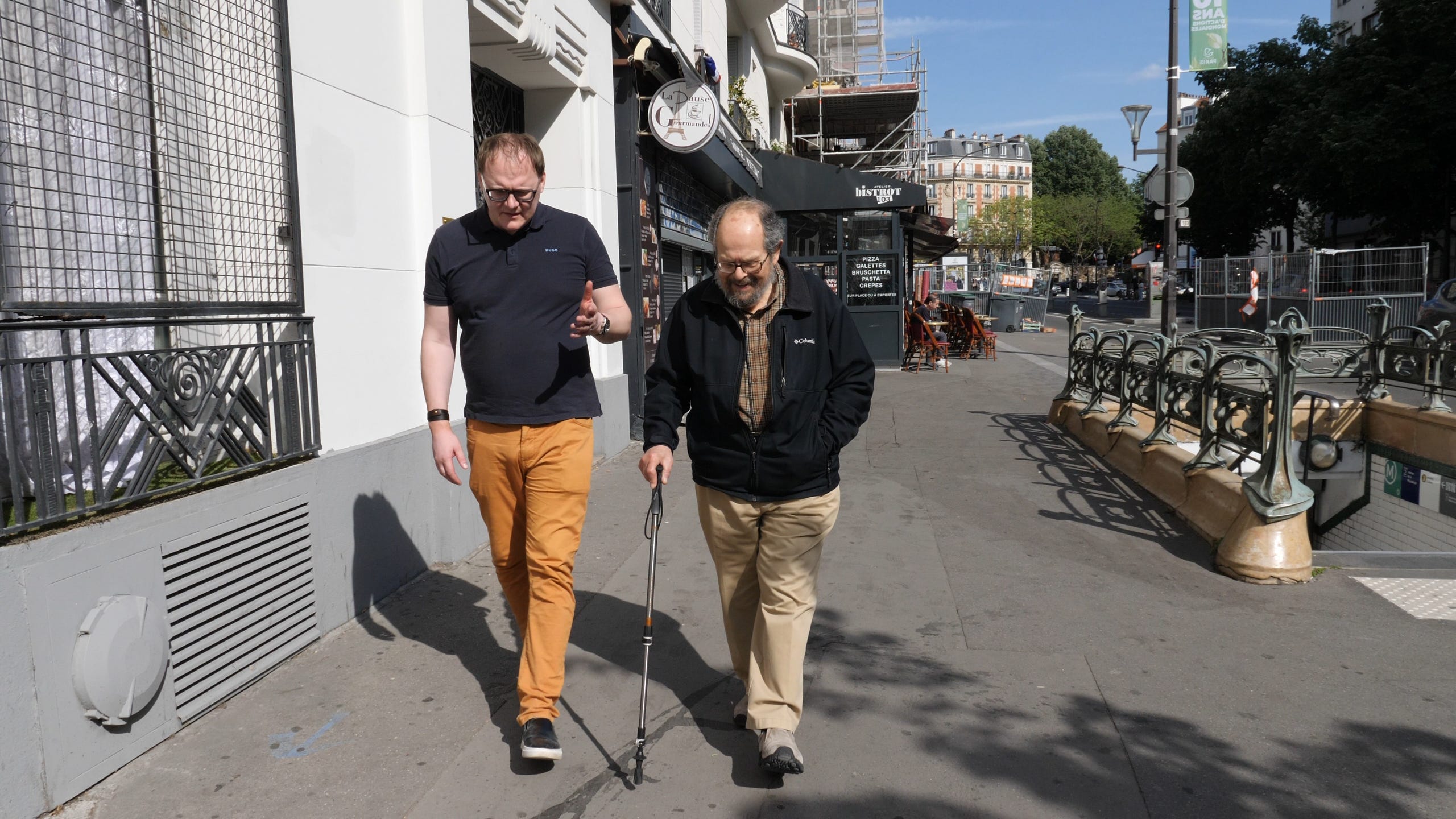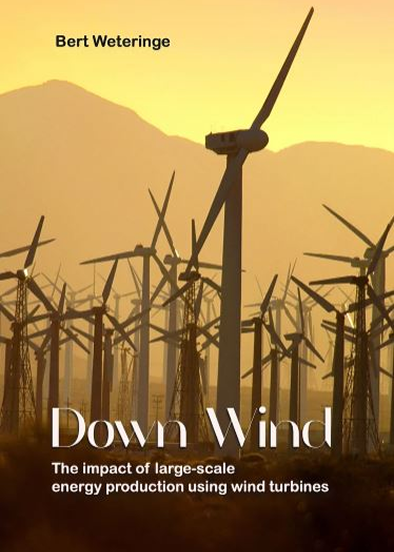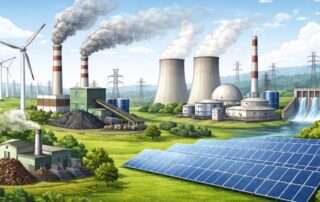INTERVIEW. Professor Richard Lindzen on Climate Change: Never Take Yourself So Seriously That You Have To Invent Problems
Atmospheric scientist Dr. Richard Lindzen explains in the interview that the current warming and climate change are nowhere near posing an existential threat to us.
Extreme weather linked to man-made climate change—Dr. Richard Lindzen, an atmospheric physicist and professor emeritus at the Massachusetts Institute of Technology (MIT), cannot think of better evidence that shows the climate crisis is a fake issue. “Issue after issue of these IPCC (UN Intergovernmental Panel on Climate Change – HS) reports, they always looked – is there any relation between extreme weather and their metric for climate. And they always find there is no statistically significant relation,” he explains.
However, some people are so concerned about the ways to push climate change and CO₂ reduction that they are going out of their minds, according to Lindzen. “They’re showing this temperature graph. And I think they’re realizing people are saying, you know, you draw it like this (going sharply up – HS), but this is one degree. That’s not much. And they’re worried: this is not getting people worried enough. So they’re saying: well, showing them a flood, showing them a storm, that would be visually convincing,” he says. And as it happens, there are always places on Earth that suffer from extreme weather in a way that occurs only once in a hundred years. “And people don’t figure it out that a once in a hundred years event is occurring some place on Earth every month, or five places every month. You have a picture of that. You now put that on television and you can associate ‘climate change’ with something dramatic,” Lindzen says. “The fact that they had to go to that to convince people suggests it was a fake issue because they’re clearly using something that would be normally called false advertising,” he adds.
In the interview, Lindzen discusses extensively what climate scientists know about climate change and its processes, as well as the half-truths and outright lies propagated by those proclaiming a climate crisis. He addresses topics such as the limited capacity of CO₂ to warm the planet and its actual role on Earth, the limited warming not actually being an existential threat to us, the absurdity of climate policies, and the future of energy.
You can watch the video version of the interview here.
Dr. Lindzen, let me start with a quote. “The fact that the developed world went into hysterics over changes in global mean temperature anomaly of a few tenths of a degree will astound future generations.” Well, you are of course familiar with the quote because it’s yours. This is from an essay that you wrote in 2009. Well, it’s now 2025.
I would have said much the same in 1990.
Really? How come?
It’s a fair question. Where did this come from? And to be honest, I don’t entirely know. Some of it began, I would say, already in 1970. In 1970 already, the environmental movement changed to an emphasis on energy. You’re too young to remember, but the first thing they were concerned with was, of course, global cooling.
Forgive me if I use this term because I think it’s a very bad term – when they speak of the Earth’s temperature, I have no idea what it means. I mean, I don’t know how you take the temperature of the Earth. Are you going to average Mount Everest with the Dead Sea?
I don’t know, but let me tell you, I’m confused because they are telling us that…
The world is warming. What are they talking about? Do you have any idea?
Professor Lindzen says there is no such thing as Earth’s temperature.
Photo: Freedom Research.
I guess average temperature?
No, we can’t average the Red Sea, the Dead Sea, with Mount Everest. What are they averaging?
So what are they talking about?
Ok, the formal definition these days is they are taking at each station a 30-year average, looking at the deviation from the 30-year average at that station, and that’s what they’re averaging. It’s the average change over the globe.
Then they have the satellites. They are doing something else, because they are measuring a thick layer of the lowest 10 kilometers or 5 kilometers, and so they are averaging a temperature because they don’t have a mountain, they don’t have a valley, it’s just air.
How do you compare them? I don’t know. People are throwing around numbers. You suddenly have a public, they’re listening, and they say: the temperature was up a tenth of a degree this year, and that’s a record-breaking year. And you say, I can’t tell a tenth of a degree if I take my temperature. The doctor doesn’t care if it’s 96.7 or 96.6. What are they talking about? But we’re somehow assuming a tenth of a degree matters.
And it doesn’t?
Does it matter to you? If the temperature changes a tenth of a degree now?
Well, we’re doing this interview in Paris, and today in Paris it’s quite a warm day.
Yeah, sure. But it’s 20 degrees warmer than it was in the morning, or 10 degrees centigrade. And we survived.
So when somebody says that a change of a tenth of a degree, or when Guterres says if it changes a half-degree, we’re finished as a species, this is an existential threat – people have to ask, what the hell are they talking about?
I have my thoughts as to why it is that educated people don’t ask questions. For most of my career, I’ve been a teacher. You have some students who are really very good, but most are okay. They’re not great. They’re going to have jobs, they’re going to do them reasonably well, and so on, but for them succeeding in school is mostly pleasing the professor. So, no matter how stupid the professor might be, they’ve learned to rationalize what the professor says. And so the skill that most people pick up at the university, I suspect, is the ability to rationalize any statement, no matter how ridiculous. So if somebody says a half-degree is the end of the world, they say: yeah, I can see that. The ordinary person does not have that skill. He knows a half-degree is small. You saw this with the farmers here (European farmers’ protests – HS), the truck drivers in Canada (Freedom Convoy – HS). None of them believes this stuff.
What do you think about the academic quality nowadays in the US and Europe?
We’re watching our universities self-destruct. It’s outrageous. If you look at Harvard University… I graduated from Harvard, I taught there, I was a professor for a dozen years. They had a president, Claudine Gay, who wrote 11 papers in her whole life, and most of them were copied from something else. How did this happen? At MIT, we have a president, Sally Kornbluth. I’m sure she’s a nice lady. She was a biologist at Duke University. She hasn’t the faintest idea what she’s doing. She needs to say she has some grand idea. So she’s decided the grand idea is climate. She knows nothing about climate. What is the big problem she’s dealing with? How to get the music department involved in the war on climate. I mean, it’s absolutely crazy.
Meanwhile, you know, if you’re a young scientist or a working scientist… I’m retired, but if you’re working today, you cannot get funding if you don’t agree with climate alarm. You cannot publish if you don’t agree with climate alarm. It’s completely taken over. And I see this at MIT. I still have colleagues who are professors, who are still teaching, and they are coming to me and saying: “I don’t know what to do. I don’t argue that there can be warming, but this is not an existential threat.” Steve Koonin (physicist Steven E. Koonin – HS) writes a book. He is looking at the UN IPCC (Intergovernmental Panel on Climate Change) reports. In the reports, you have many different sections. Only one deals with science. That scientific report never says that it’s a big deal. It simply says, we’re more likely to warm than to cool, and it’ll be a few degrees, maybe. But nobody in those scientific reports is saying there’s going to be extreme weather, or it’s going to be floodin,g or the world is going to end. Now, that’s politicians. And the politicians have arranged the UN reports so that you do have one section on science, and then you have lots of other sections that are not on science that say crazy things. And so you say the UN says this, but it doesn’t say it in the science section. They designed it so that they would have a platform for issuing crazy statements. That there would be one section that is the science that no one would read, but allows them to say they had hundreds of scientists working on this.
Some decades ago, you were also working with these scientific reports.
Yes, I was working with the IPCC, and you know it was absurd. In order to write three or four pages with two other people, we traveled around the Earth two or three times. There was a meeting in New Zealand, a meeting in Nairobi. And the three of us… There was a fellow called Pierrehumbert, who’s today at Oxford (American geophysicist Raymond Pierrehumbert – HS). There was another guy from France. We all decided that we may not agree, but let’s not say anything that we know is false. So the section was on what we knew about feedbacks. And it was a completely honest section. It was biased. We were told we couldn’t attack models too much. But basically, what we wrote was honest. It said we didn’t know what we were doing.
Professor Lindzen says that we are watching our universities self-destruct.
Photo: Freedom Research.
So models, computer models.
Models are their own story. Models are useful. But not for prediction. The reason they’re not good for prediction is we don’t know the feedbacks, we don’t know clouds, we don’t know and resolve other things. So they cannot handle processes that are essential. They’re useful if you’re doing theory. You can look at the models and see how things interacted and then focus on those more carefully to see whether you understand the interaction. So there is a kind of back and forth between models and theory, and so on. But that isn’t how they’re used.
The issue began with having no science at all. It began, as I said, with global cooling. As long as there was some way this number, this crazy number, was showing cooling since from about 1939 to 1973, they said, well, let’s say it’s cooling. And then you had models as well – they were called the Budyko-Sellers models (after Russian and US climatologists Mikhail Budyko and William Sellers – HS). All of us liked to play with them. They were cute. They showed that if you reflected light with sulfates enough, the original version of the model would give you an ice-covered Earth. That seemed very dramatic. And then people, including us, began showing that, well, if you put in something more realistic in the tropics, it stopped there at 30 degrees. And then finally, in my course notes, I have a problem where you put into this model the change of seasons, and the model falls apart completely.
So, for the global cooling, you had the model you needed to give a scare story for cooling. But then in ’73, in the 70s, it stopped cooling. So you needed something else. What was the next thing that came up? It was, again, the energy sector. Acid rain. The forest in Germany was dying. Unfortunately, after a few years, the forest stopped dying. So, acid rain was not too useful. People tested it. They found it didn’t have much impact.
But then they noticed the temperature was increasing, and that they liked. Why did they like it? Because the reason you would give for the temperature increasing is that CO₂ was increasing. Why did they like CO₂? Well, with global cooling, you are worried about sulfate aerosols. The trouble with sulfate aerosols is we know how to clean them. We can build a coal plant that has no sulfate emissions. Well, what good is that!? CO₂ – nothing can stop that. It is the product of any burning, including breathing.
So you generate a lot of CO₂. Anything that burns a fossil fuel produces CO₂. After you clean every real pollutant out, you still have CO₂. So this was guaranteed to get rid of any fossil fuel. And that was its attraction. And that’s what we’ve gone with for the last, since ’88.
And it was interesting… You were a little surprised when I said it began many years ago. In 1988, you had a Senate hearing in the US, and you had a man called James Hansen (US climatologist – HS) testifying. He came there and said that increasing CO₂ was going to cause a lot of warming. And Newsweek had a cover showing the Earth on fire, and it had a label: “All scientists agree”. And that was very interesting, because at that time, almost no scientists were working on this. People were told all scientists agree. Now, think of that from a propaganda point of view. You don’t know science, you haven’t studied it, most people haven’t studied it. Even among the people who studied the science, for this problem, a big part of the problem is fluid mechanics. Almost no physicist ever studies fluid mechanics. So you have something that hardly anyone has studied. And you’re saying: “What am I going to do? I don’t understand this.” You are told all scientists agree. This is a source of comfort. You don’t have to understand it. If all scientists agree, you can agree, too.
We hear it more and more nowadays. That there is now a 97 per cent consensus.
Oh, that’s fake! How should I put it? It always depends on the question. So, for instance, if you asked a question if doubling CO₂ is more likely to warm than to cool the Earth, I would think you’d get 100% agreement. But that’s not the same as saying it’s a serious problem. So, at that level, if you ask the right question and put a funny interpretation on the answer, you can say all scientists agree. You just haven’t said what they agree with.
Then you have the paper by Cook that said 97% (Cook et al. 2013). They looked at journals and tried to find articles that discussed certain impacts of climate. And so they looked at, don’t take my numbers seriously – they looked at 1,000 articles, they found 40 articles that spoke about certain impacts. And for those 40 articles, they found 97% said so, and so they said 97% said that. But it was like a few percent of the total (the case was even worse: it was ca 40 out of ca 12,000 – HS).
What is your opinion on this phrase itself: consensus, scientific consensus? Is it something that science is made of? Is it made of consensus?
No, of course not. Whenever you hear consensus science, you know something is wrong. So, for instance, you know, this was in the Soviet Union with (agronomist Trofim – HS) Lysenko. Yes, there was a consensus in favor of his view of evolution, because if you disagreed, you went to the GULAG. It’s a powerful argument?!
Today, it’s equally true if you’re teaching. If you’re not part of the consensus, you don’t get paid. It’s better than the GULAG, but, you know… .
What is the state of climate science and climate teaching in the university?
It’s horrible. First of all, there is so much money thrown at climate. As I mentioned to you, when the issue began in public in ’88, you had very few departments and very few people working on climate. All of a sudden, when the government is providing money, when the UN and the EU are providing money, every university now has a climate group. It doesn’t advance the subject because no one is permitted to actually study it. If you actually studied it, you would see this makes no sense.
We actually wrote a paper about a year ago, trying to address the question – why do you argue that a degree, one degree, is important? And if you pressure people who are working on it, they will say something like, there is polar amplification. That whatever you do in the tropics is amplified at the poles. For people who worked on the theory, they know this isn’t true. What determines the temperature difference between the tropics and the pole is the fluid mechanics that produces the high and low pressure areas that you see on your weather map. And they carry heat to the pole, and they determine the temperature difference. It’s not an amplification of the tropics. But you can at least ask the question – does the data show that it is? And what we were able to show is that in the data from about the early 19th century to the present, there is no polar amplification. So all that you’re getting is that half-degree, that one degree. One degree every place is all the contribution from greenhouse. And for practical purposes, this is much smaller than the actual climate change that has occurred. The Gulf Coast of the US has gotten much colder. That is a change. But it doesn’t reflect itself in the equator to pole, tropics to pole, it’s local. And in fact, most of the climate change associated with time scales from about three or four years for El Niño to a thousand years, let’s say the medieval warm period, are probably due to the ocean. The ocean is much denser than the atmosphere, obviously, and as a result, its circulations take much longer. They involve much more mass. And so ocean circulations, depending on their depth, they’re up to a thousand years. And what happens? You have circulations that are taking heat away from the surface and bringing heat to the surface. So the surface is never in equilibrium with space, which is the basis of a lot of the simple discussions. It’s always changing the surface, but it changes it locally. Different ocean currents are peculiar to different regions of the ocean.
We know that the Earth has many different climates already. The climate in the Sahara is different from the Mediterranean coast, is different from Scandinavia, is different from the Baltics, and so on. But if you look at each region, let’s say Tallinn and London, or Tallinn and New York, the changes don’t correlate. They’re each different. And so you have a world where climate change is occurring always, and on time scales that we’re looking at, like the medieval warm period, the Little Ice Age, and so on, it’ll be very hard to understand because it’ll involve all the details of the ocean interacting with the air. You then have the big changes. The last glacial maximum, when half of North America was covered in two kilometers of ice, and you have the Fennoscandian ice, and so on.
You also have 50 million years ago, the Eocene, when you had alligators or like alligators in Spitsbergen. Those involved the changes in temperature from the tropics to the pole. That depends on fluid mechanics, it’s internal, and it depends on surface conditions. By that I mean, you know, if you have ice or snow on the surface, it changes the response at the surface to the waves, the highs and the lows. It’s somewhat complicated, but people have worked it out. There are papers that have done this. They’re very hard to follow. This has been true for a long time. Do you know the name Werner Heisenberg?
Professor Lindzen argues that human impact on climate is marginal at best.
Photo: Freedom Research.
A physicist?
Yes. And he’s associated with the uncertainty principle. But his doctoral thesis was on fluid mechanics. And he made the point that fluid mechanics is hard, and we still have no understanding of turbulence and all these things, but it’s a crucial part. When you look at a weather map and you see the highs and lows, this is a form of turbulence. It’s just that when you’re looking at it in a boiling pot, the eddies are small. When you look at it on the scale of the Earth, they’re the size of countries. But they’re still turbulent eddies. We know that they are separate from the greenhouse.
So in terms of our knowledge of the system, it’s not zero. And we know it doesn’t fit the picture that is being talked about.
But you asked how many people work on it and so on. By now, when the government gives out money, hundreds of universities all have climate issues, but they haven’t got the people to train people in the physics. So they all sort of agree. And you have things like I mentioned at MIT, where the president of MIT worries about how to get the music department to fight climate.
Do humans have some impact on the climate, or what is your opinion on that?
At some level. The cities have a different climate from the countryside. That’s a human impact. It’s called the urban heat island. A broader impact on climate? I doubt it.
But why is it then that this global warming debate is so much focused on CO₂?
Because it’s not a debate. And it began essentially in the 70s. There was a man called Manabe (Japanese-American climatologist Syukuro Manabe – HS). He wrote a paper in 1973, and he argued that if you modeled the atmosphere with a one-dimensional model – remember, we have three dimensions, and time. He got rid of time, he got rid of two of the dimensions, and had just the vertical. And he said that, if I assume that as the atmosphere warms from increasing CO₂, and doubling CO₂ gives you a half-degree, it’s not much. And he says, if you assume that at the same time the relative humidity stays constant, so that when you warm, you have more water vapor, then that will double the impact of the doubling CO₂. And that was a revelation! A false revelation, but a revelation because until then, there was something called Le Chatelier’s principle. Le Chatelier’s principle was never proven, but it was an argument that nature tries to prevent change. Manabe has come up with something now that says that if his assumption is correct, nature can amplify what man does. Which sounds like something very strange for nature to do, but it became the heart of all the models. They all now tried to arrange things so that clouds and water and everything amplified whatever man did. And Manabe got a Nobel Prize in Physics for this (in 2021 – HS). Even though it’s never been confirmed, it doesn’t seem to be true. But it allowed you to make models that were more sensitive.
CO₂ does almost nothing by itself. When you have very little CO₂, each molecule is pretty effective. But we have so much CO₂ in the atmosphere that even though it sounds like not much, it already blocks infrared. I’ve said this for about 50 years. If you take your window and paint it black, it’ll keep out a lot of light. You now add a second coat of black. Does it keep out as much light? No, there’s no light coming through, so it does less and less. That’s what happens with CO₂. We have so much already that when you add a molecule, it doesn’t do much. And this has been known since a man called (Svante – HS) Arrhenius, a Swede, around 1900. The way it shows up is you get the same effect of CO₂ every time you double CO₂. So, for instance, if you start out at 280 parts per million and you go to 560, doubling it, you get about a half-degree. Now to get another half-degree, you have to double 560 to 1120. So now instead of 280, you need 560. And then to get another half-degree, you’d have to add a thousand. So each molecule does less than its previous one.
And that’s been known, as I say, for more than a century.
There are those big projects now built with taxpayer funds. Those big fans that suck CO₂ out of the air and as I understand, this CO₂ is then moved to Iceland where there is a factory there that makes rocks out of CO₂. What do you think of such projects?
How should I put it? Do you know the name Hayek, von Hayek?
Yes, of course. Liberal economist.
He disliked engineers. And at MIT, I can understand a little bit why. Engineers love to solve problems, even if the problem doesn’t exist. And so you tell an engineer, CO₂ is a problem. He goes to work. How do I get rid of CO₂? And if he’s entrepreneurial, he’ll start a company to get rid of CO₂. So, they’re, in a way, an uncontrollable function that will respond to anything you call a problem.
But let me ask a simple question, because I don’t think people even understand. What happens if I get rid of about 60-65% of the CO₂ in the atmosphere? Do you have any idea?
No, I don’t. I have a suspicion. I suspect that it is not going to be very good for nature.
Forget the nature. How about us? We’ll die. We’ll die of starvation. At 160 parts per million, virtually no plant will survive. No plant survives, there’s no food.
So CO₂ is very important, but it’s demonized irrationally, and really, I’m puzzled. I cannot get it to my head. Why is it done?
I think for the same reason that years ago, as a joke, someone asked people, is it a good idea to get rid of H₂O? They said, yes, it’s a chemical. We get rid of chemicals!
Some people still use the word climate crisis to describe today’s situation, or at least say that we are heading towards a climate crisis.
What is a climate crisis?
That’s what I wanted to ask.
I don’t know. I mean, they often give you a picture of New York underwater.
Professor Lindzen says he really does not know what would be a ‘climate crisis’.
Photo: Freedom Research.
It would be a crisis.
It would be a crisis if it were true. But even if it were true, how shall I put it? We’re talking about thousands of years. A thousand years ago, what was in New York? Nothing. You had the geography, there were some Native Americans living there, but nothing special. A thousand years from now, who knows? But it’s perfectly clear that if the coast of the U.S. were 40 miles inland from today, the U.S. would still be a viable country. And instead of New York, you would have Philadelphia or Chicago.
I don’t know how to talk about a thousand years from now. And nobody 300 years ago knew how to talk about today.
There is a lot of talk about those tipping points. They are saying that if the temperature rises, small changes will bring big consequences.
It’s a statement that if you go beyond a certain limit, you then leap. This is a property mostly of systems that have what are called very few degrees of freedom. So when you have a system that has very few possibilities, then if you push it too hard, it has to jump to something. This is not a property of a continuous system like climate. The climate does not go through tipping points. This is an artifact that people who want to generate a scare story throw out. And if you’re not a scientist, you say, gee, what is this tipping point? But it’s not for a system that is continuous. It’s for a system that has no choice. Our system has lots of choices.
You mentioned extreme weather events. This is a claim that is being made, the crisis is linked to extreme weather events.
I think there’s no better evidence that this is a fake issue. Issue after issue of these IPCC reports, they always looked – is there any relation between extreme weather and their metric for climate. And they always find there is no statistically significant relation. In the meantime, you have the people who are pushing climate change and CO₂ reduction, and they’re going out of their minds. How can they convince people to get worried? And so they’re showing this temperature graph. And I think they’re realizing, people are saying, you know, you draw it like this (going sharply up – HS), but this is one degree. That’s not much. And they’re worried: this is not getting people worried enough. So they’re saying: well, showing them a flood, showing them a storm, that would be visually convincing.
You know, you could get five or six pictures each month of some place on the Earth where something dramatic has happened. And you can say: this is a once in a hundred years event! And people don’t figure it out that a once in a hundred years event is occurring some place on the Earth every month, or five places every month. You have a picture of that. You now put that on television, and you can associate ‘climate change’ with something dramatic. And people see something dramatic, and so this helps them to visualize some terrible future. The fact that they had to go to that to convince people suggests it was a fake issue to begin with, because they’re clearly using something that would be normally called false advertising.
What people are often told in regards to climate is that if we don’t do anything about it, there will be climate change and there will be climate refugees, and it’s going to be worse.
They’re told that, and they never ask, how come? What is it about a half-degree that is going to cause people to migrate that are not migrating already?
The public never does arithmetic. They hear that if Europe and the US and Australia, and New Zealand all stop producing CO₂, it won’t do much. First of all, because China and India are continuing, but it really wouldn’t do much anyway. So what are people told? Everyone must do their part! And so you have people willing to do something even though they know it will have no impact.
It’s appealing in a way to people’s good nature, or wishing to do something important, and getting them to commit suicide. Look at Germany today, they’re losing their industry. BMW is made in Hungary, as far as I can tell. Their unemployment is increasing.
Let’s talk about energy policies, and climate policies as well, that are currently still moving on in Europe – the move towards Net Zero. At what cost will it be achievable? Is it even achievable?
It’s a wonderful example of the breakdown of what people call cost-benefit. Will Happer (physicist and Princeton emeritus professor William Happer – HS) and I have a little note pointing out that if you reach Net Zero by 2050, if you do it worldwide, you avoid about a third of a degree. If it’s just Europe and the Anglosphere, it’s closer to a tenth of a degree.
So you have avoided a tenth of a degree of warming at a cost probably of tens of trillions of dollars. Doesn’t seem like a bargain to me.
But as I say, the trouble with it is the political calculation. If a politician in America can give away trillions of dollars, he can get back enough to run for office for the rest of his life. Politicians do not get a high pay, and yet they end up with the biggest mansions, expensive cars, and so on. It’s a question that people occasionally wonder about. But climate is a good vehicle for this, because the energy sector is so big.
What do you think about reducing fossil fuels? Should we do it still?
Until the end of the 18th century, human existence was relatively static. Population didn’t change much. Standard of living didn’t change much. And all of a sudden, at the end of the 18th century, you began this astounding increase where the population is increasing, the wealth is increasing, the income is increasing, life expectancy is increasing.
I mean, it makes you wonder when you just correlate things and call it causality – is it that life expectancy is increasing, that’s causing warming? It just gets crazy.
But what happened? What caused that? The steam engine. All of a sudden, mankind was able to exercise more energy than he himself could produce by designing engines. And ever since then, we’ve gotten better and better at that. And that has led to the greatest increase in human welfare in history. And we’re now feeling guilty about it.
Yes, we do. We want to stop it, to be exact.
No, we want to stop it for the people who are still poor.
As I understand, policies are in place not to allow, for example, Africa to develop, because of climate.
(ironically) It’s their obligation to us!?
Morally, it feels kind of repulsive.
How shall I put it? Fortunately, they don’t agree.
The only reason I could see for reducing fossil fuels is a concern that we’re running out. And then you might want to limit your usage. But that seems to me also a little bit naive because at present, fossil fuels are the basis, to a large extent, of societal prosperity. It will only be prosperous societies, I think, that can afford the research to look into other things. Obviously nuclear has a role, and with the modular systems, it’ll overcome one of the problems with nuclear, which is starting it up and down and changing it by small amounts to adjust to the load. So nuclear has the potential for providing energy for a long, long time by historical standards, and then there’s fusion. And that always seems to be in the distant future. But in a few hundred years, I think we’ll probably have a good idea of how to do controlled fusion. So I don’t worry too much. At the moment, the supplies of fossil fuel are increasing. When we added fracking, all of a sudden, we had access to much more fossil fuel. There will be improvements like that. We really don’t know how much there is. So far, we have generally underestimated how much there is. So between those factors, new methods of extraction, fission, nuclear, fusion, I think one can expect a future in which energy is in stable relation to population.
We have bigger problems potentially coming up. I find it ironic that we’re suddenly waking up to the fact that we don’t have enough people. I think your generation is finally waking up that if population keeps going down, nobody will pay for your retirement. And it’s happening even in Africa. There are all sorts of problems that are coming up that we’re not thinking about while we think about problems that are not coming up. Never take yourself so seriously that you have to invent problems.
Hannes Sarv (Freedom Research) interviewed Professor Lindzen in Paris in May.
Photo: Freedom Research.
What advice would you give to our Estonian politicians? Of course, we have plans to go to Net Zero, and we have plans that in 2030, we produce annually as much energy from renewables as we consume. So 100% or even 120%. Does it even sound logical to you?
First thing I have to say, I think Trump is doing the correct thing. He is ignoring all the climate issues and saying: “Drill, baby, drill.” The U.S. is big enough that when it decides to ignore the whole thing, I think the rest of the world has to think twice. If the US is ignoring it, China is ignoring it, India is ignoring it, Southeast Asia is ignoring it, and Russia is ignoring it, why commit suicide? There may be guilt, there may be all sorts of things, but you don’t need an energy policy, you need a psychiatrist.
With 2030 and Net Zero, this is posturing. It’s impossible. And it’ll do nothing. So this is a kind of, how should I put it, a funny sort of dance that people are doing. And I don’t understand it. But it’s caught on. It can’t go, can’t work, won’t happen.
And as far as renewables go, nothing you say makes them less intermittent. If you say you’ve done 110% with renewables, what happens when the wind doesn’t blow, when the sun doesn’t shine? What happened to your 100%? It’s gone. And the trouble is, and this has been one of the obvious things, why are renewables so expensive? People are thinking that we don’t have to pay for sunlight. How come my electricity bill goes up so much? Well, first of all, among other things, they don’t work all the time. And if you have to take your fossil fuels, your natural gas or your coal, and turn it on and turn it off and turn it on and turn it off, your efficiency goes way down. So, in addition to using the ‘renewables’, you are also being forced to use the traditional sources in the most inefficient way possible. This makes no sense.
The EU and European countries in general are behaving very strangely. I don’t know how they will respond to what Trump is doing. But what he’s doing is making it obvious what Europe is doing will be of no help to the climate and will hurt Europe. How far will the population go in saying we will sacrifice ourselves for a symbolic gesture? I don’t know. I mean, this is again a statement of peculiar behavior.
What advice would you give? How to come out of this thing as a politician?
The easiest way is what Trump is doing. The EU is such a complex system. I don’t understand how the European Commission can have the power it has. And you know the way they refer to it: the democratic deficit. That suddenly you give power to a group who you never elect. I think it’s a bad idea. I hope it changes eventually. I think you can have an organization that has a passive role to investigate things, but you can’t have a bureaucratic body that has powers that replace democracy. So it’s tied up to many things. I think if individual countries have a choice, they’ll each decide probably to drop the climate issue.
And to be honest, 50 years will pass. There will be no climate catastrophe. 2030 will pass, 2050 will pass, just like 2000. (US ex-VP and climate activist Al – HS) Gore predicted New York underwater by 2000. We should notice it’s still above water. All these predictions always fail. At some point, you have to say, if all the predictions fail, maybe your ideas are wrong.
I’m optimistic that there does come a point when people say that, and it will be interesting to see if in Europe individual countries understand this and the European Commission does not. What will happen? I would suppose they would have to decide that the European Commission is useless. So there is a more optimistic future.
Dr. Richard Lindzen is an internationally recognized American atmospheric scientist and MIT emeritus professor who has made signficant contributions to our understanding of climate and climate science. Over the course of his career, Lindzen has published almost 250 scientific papers, exploring the greenhouse effect and other complex aspects of climate change, like dynamic meteorology, hydrodynamic instability, planetary waves, monsoon meteorology, planetary atmospheres, and hydrodynamic instability. His research has involved studies about the role of the tropics in mid-latitude weather and global heat transport, the moisture budget and its role in global change, the origins of ice ages, seasonal effects in atmospheric transport, stratospheric waves, and the observational determination of climate sensitivity. He has made major contributions to the development of the current theory for the Hadley Circulation, which dominates the atmospheric transport of heat and momentum from the tropics to higher latitudes and has advanced the understanding of the role of small-scale gravity waves in producing the reversal of global temperature gradients at the mesopause. He pioneered the study of how ozone photochemistry, radiative transfer, and dynamics interact with each other.
Lindzen has also contributed to the scientific reports of the United Nations Intergovernmental Panel on Climate Change (IPCC).
He earned his doctorate from Harvard University in 1964. He served as a professor there until 1983 and as Director of the Center for Earth and Planetary Physics from 1980 to 1983. Lindzen has been affiliated with Tel Aviv University, The Hebrew University in Jerusalem, and the Laboratory for Dynamic Meteorology, Paris, as a visiting professor during his academic career. In 1983 he joined MIT, where he became a professor of atmospheric sciences. Lindzen retired in 2013.
Lindzen has been recognized for his scientific contributions with several prestigious awards. The American Meteorological Society honored him with the Clarence Leroy Meisinger Award (1968) and the Jule Charney Award (1985) for ‘highly significant research in atmospheric sciences’. The American Geophysical Union awarded him the James B. Macelwane Medal (1969), and the Engineers’ Council recognized him for outstanding achievements in engineering (2009), among other honors.
Lindzen is a member of both the U.S. National Academy of Sciences (elected in 1977) and the American Academy of Arts and Sciences (elected in 1977).
more news
Africa’s Pipeline Rejects Climate Dogma and Foreign Control
Political powers in the United Nations and European Union have spent decades lecturing Africa on climate “virtue.” Net-zero pledges, renewable targets, ESG frameworks and more make up the ever-growing list of prescriptions for “healing the planet.”
Dismantlement of South Africa’s Ferrochrome Industry
South Africa’s once dominant ferrochrome industry is on the brink of collapse and requires a government bailout. That decline is not because the world no longer needs ferrochrome. It is because South Africa’s leaders tied their industrial policy to a “green” agenda that undermines reliable, affordable energy and sacrifices economic strength.
“Should LCOE finally be retired from energy policy?”
“The LCOE narrative has just collided with reality. If ‘cheap’ solar and wind really were enough, the energy transition would largely run on autopilot. Emissions would fall. Subsidies wouldn’t be needed. Electricity would get cheaper. None of that is happening.” – Jonas Kristiansen Nøland, Norwegian University of Science and Technology
